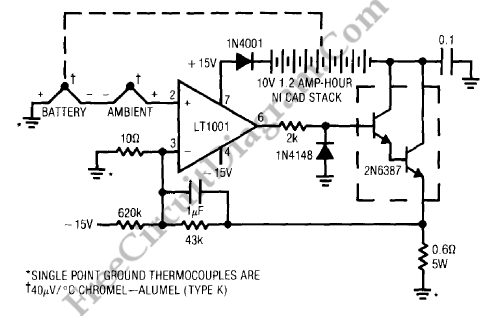Ni Cad Charger with Thermal Control

Ni Cad batteries can be charged at high current rates because it allows short charge time. But, it has difficulty in operations such as excessive internal heating degrades the batteries and can cause gas venting to the outside atmosphere. Because cell voltage is not necessarily indicative of the charge state of the battery , schemes based on monitoring cell voltage during charge surfer. For ambient temperature and battery characteristic shifts over life, open loop techniques involving high charge rates for a fixed time do not account.

Measure cell temperature and taper the charge accordingly is one way to charge batteries fast without abuse. The figure below shows thermocouple usage for this function. The effects of ambient temperature is made zero by the second thermocouple. The low level capability necessary to work with the microvolt level thermocouple signals is furnished by LT1001. Assume a discharged battery pack in the Darlington collector line to understand the circuit’s operation. The ambient thermocouple and battery are at the same temperature. The battery thermocouple is directly mounted to one of the cells in the pack. Expose the ambient thermocouple to ambient temperature and mounted to thermal mass which approximates that of the battery pack. Under these condition, the positive input is at zero volts and the thermocouple voltages cancel. The swing of amplifier which is made the Darlington pair turning on is caused by the negative current through the 620Kohm resistor to the summing junction. From the 15V supply, through the battery pack and to ground via the 0.6Ohm shunt is the way of current flow. The voltage across the shunt increases to 1V, balancing the summing junction, and about 1.6A controlled by amplifier servo through the battery pack. It heats as the battery charges. The battery-mounted thermocouple takes this heat. The voltage which appears at the amplifier’s positive input is determined by the temperature difference between the two thermocouples. This small negative voltage (1’C difference between the thermocouples equals 40uV) becomes larger as battery temperatures rises. The current greatly reduced through the battery by the amplifier which is operate at gain of 4300 to maintain its inputs at balance. The battery charges at a high rate until heating occurs and the circuit then tapers the charge. The value given in the circuit limit the battery surface temperature increase over ambient to about 5’C. [Source: Linear Technology Application Note]